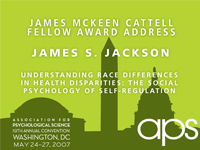Motivational Speakers
Like many people, I start my day with a cup of coffee. A small vice, yes, but I have few reservations about my artificial boost of motivation.
This, of course, isn’t the only thing that pushes me — and presumably the rest of the coffee drinkers of the world — to be a go-getter. As I learned at the themed program “Cross-Cutting Perspectives on Motivation” at the APS 19th Annual Convention, there are a lot of ways to get motivated.
Why Even Bother?
Motivation has taken a back seat to cognition in many research programs in recent decades, but lest we forget, psychologists have long relied on motivation to explain behavior (see Freud, Sigmund). APS Fellow and Charter Member Charles Carver, University of Miami, sees a resurgence of research on motivation beyond the relics of the Freudian ego and superego. Carver sees motivation more like biological homeostasis in which a series of feedback loops are working overtime not only to pull us in the direction of our wants and desires but also to ensure we stay well away from what he describes as “anti-goals.”
Our affect is inextricably linked to this “action” feedback, according to Carver. “If you’re going too slow, negative affect arises and you try to speed up. If you’re going too fast, positive affect arises and you tend to slow down.” Our tendency to coast when we are progressing at above-average speeds is a sort of cruise control; it’s not that we’re giving up, just gliding along a bit.
 APS Fellow Roy Baumeister, Florida State University, takes another, less orthodox, view of motivation. Traditionally, motivation is thought of as a satiation cycle: You want something, you get it, eventually you want it again, and so on. Baumeister instead proposes the inverse: that getting something ultimately results in wanting it more. He tested this hypothesis by giving students either a handheld video game or crossword puzzle and instructing them to play for 20 minutes a day. After five days, the participants returned to conduct an unrelated experiment and to answer some filler questions. Baumeister then provided the participants a choice of several activities to do, one of which was the game they had played during the previous days. As his “getting begets wanting” theory would expect, the participants reached for their game more often than not.
APS Fellow Roy Baumeister, Florida State University, takes another, less orthodox, view of motivation. Traditionally, motivation is thought of as a satiation cycle: You want something, you get it, eventually you want it again, and so on. Baumeister instead proposes the inverse: that getting something ultimately results in wanting it more. He tested this hypothesis by giving students either a handheld video game or crossword puzzle and instructing them to play for 20 minutes a day. After five days, the participants returned to conduct an unrelated experiment and to answer some filler questions. Baumeister then provided the participants a choice of several activities to do, one of which was the game they had played during the previous days. As his “getting begets wanting” theory would expect, the participants reached for their game more often than not.
Baumeister’s research supports a model of motivation that closely resembles drug addiction, something that may seem counterintuitive at first. “Instead of addiction being the special case and hunger being the prototype,” he suggests, “maybe it’s the other way around.”
Making an Effort
When we think about motivation, we often think of the directional aspects. That is, we think of the things we want to achieve or obtain and proceed on the appropriate path to do so. But an equally important aspect of motivation involves how persistent we are willing to become in order to achieve these goals.
John Salamone, University of Connecticut, studies the biological underpinnings of our “vigor” in motivation. Salamone’s research has discovered that dopamine, particularly in the nucleus accumbens, is heavily involved in effort-related decision making.
In one experiment, rats are put in a “T” maze. On one side is a large number of food pellets that the rats have demonstrated to be their food of choice. On the other is a smaller number of food pellets. The rub is that a barrier separates the rat from the side with the large amount of food. Normal rats will take the time to scale the barrier to get the large supply of palatable pellets. Dopamine-depleted rats, however, are content to chose the arm with the small number of pellets, which require less work.
Acknowledging the importance of effort in decision-making, New York University psychologist Nathaniel Daw has attempted to incorporate one’s drive to reach the goal into models of reinforcement learning. When humans are evaluating how valuable accomplishing a certain goal will be in the future, we take several things into account: whether there is some immediate value to accomplishing this goal, how much effort will be required, and how much time it will take to accomplish it. Humans are constantly making cost/benefit analyses of these key ingredients to determine how vigorously they should pursue the goal.
Motivation in the Real World
The role of motivation lies at the core of many significant real-world problems, as Ruth Kanfer, Georgia Tech, and Jacquelynne Eccles, University of Michigan, pointed out in their talks.
Kanfer, an industrial/organizational psychologist and APS Fellow and Charter Member, has spent considerable time examining the role motivation plays in the workforce as baby boomers age and transition to retirement. One of the biggest misconceptions, Kanfer points out, is the belief that age-related decline in work motivation is universal or inevitable. “There is no evidence for an intrinsic loss of motivation for work or at work,” she says.
Kanfer points out that as workers age, their values, interests, and needs change. For entry-level workers, salient goals are often related to growth, achievement, and an opportunity for challenges, whereas older workers may place a greater value on financial security and satisfaction of intrinsic goals such as enjoyment, identity, affiliation, and growth. She said that by understanding the dynamics of job demands, motives, and motivational processes, employers will be better able to target older employees with the incentives that continue to motivate them and sustain their performance.
APS Fellow Jacquelynne Eccles has focused her research on the question, “Why are females less likely to go into math and physical science than males?” Eccles followed a group of adolescents from ages 12 through 25, tracking their school and career trajectories in order to examine why there are so many more males than females in the so-called “hard” sciences — physical sciences, engineering, and math.
Her results suggest that test scores or ability self-concepts are not the culprits for low participation in the hard sciences. Rather, it is the “subjective task value,” the stock that genders put into math, engineering, and physical sciences. “It’s actually the value, not the expectation that matters,” Eccles reports. The female students in the Eccles study reported seeing less utility for math and the sciences, leading them to take fewer advanced courses in each subject. These results suggest that programs aimed at increasing girls’ self-confidence about their math and science abilities are probably misguided and should instead be aimed at demonstrating the value of math, engineering, and the physical sciences.
Thus, motivation has managed to trickle its way from our neurons all the way to dictating public policy. Whether it is the undeniable urge for more or the fear of failure that drives our actions, motivation proves to be a formidable force in explaining our behavior.




Comments
It’s interesting to learn that when it comes to hiring a motivational speaker that there are benefits that can come from getting one. I like how you mentioned that this is the company making an effort to obtain or proceed to the path that they are wanting them to be on. This is something that a company will have to remember when it comes to choosing the one that will know about the path they want to be.
APS regularly opens certain online articles for discussion on our website. Effective February 2021, you must be a logged-in APS member to post comments. By posting a comment, you agree to our Community Guidelines and the display of your profile information, including your name and affiliation. Any opinions, findings, conclusions, or recommendations present in article comments are those of the writers and do not necessarily reflect the views of APS or the article’s author. For more information, please see our Community Guidelines.
Please login with your APS account to comment.